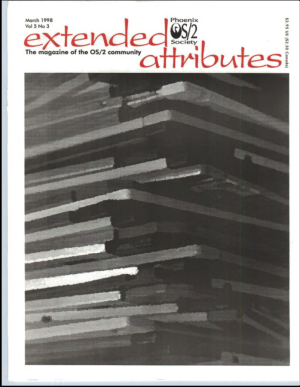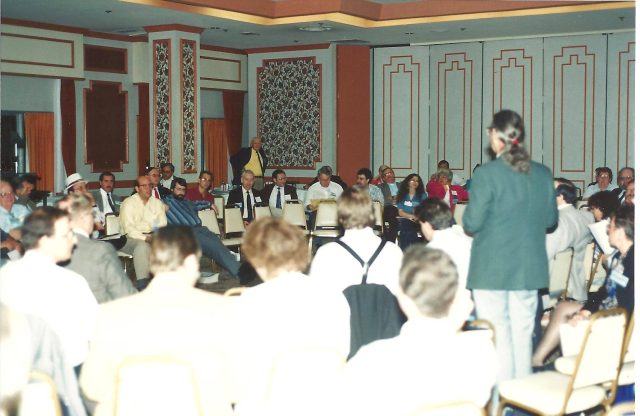The Homebrew Computer Club where the Apple I got its start is deservedly famous—but it's far from tech history's only community gathering centered on CPUs. Throughout the 70s and into the 90s, groups around the world helped hapless users figure out their computer systems, learn about technology trends, and discover the latest whiz-bang applications. And these groups didn't stick to Slacks, email threads, or forums; the meetings often happened IRL.
But to my dismay, many young technically-inclined whippersnappers are completely unaware of computer user groups existence and their importance in the personal computers development. Thats a damned shame. Our current reality may largely be isolated to screens, but these organizations helped countless enthusiasts find community because of them. Computer groups celebrated the industrys fundamental values: a delight in technologys capabilities, a willingness to share knowledge, and a tacit understanding that were all here to help one another.
And gosh, they were fun.
For example, David Intersimone began attending the Southern California Computer Society in 1975. At one meeting, he bought an early IMSAI 8080 kit and soldered it together at home. “The lights lit but the processor would not reset and stop,” Intersimone recalls.
So at the next meeting, he introduced himself to “the computer doctor,” who was recommended as someone willing to help kit newbies. The "doctor" was able to fix Intersimone's soldering errors, and he also suggested that Intersimone buy a Godbout Electronics S-100 bus terminator card to quiet the non-solder-masked motherboard. “Finally, my IMSAI 8080 was working," Intersimone says, "and it still works today!”
Old-school programmers may recall Intersimone's long career at Borland; these days, he is VP of Developer Communities at Evans Data Corporation. And the computer doctor? He was George Tate—of Ashton Tate and dBase fame.
This collegial experience, often leading to careers in the growing PC industry, was typical during the heyday of computer user groups. So take a wander into the wayback machine with me to revisit what made them so special.
Newsletters were a huge part of the computer user group scene. The Michigan Atari Computer Enthusiasts published this gem in January 1984—an "Early bird C.E.S. report!" Archive.org This October 1990 issue from the Apple 2000 group (a national computer user group for Apple enthusiasts) features a review of Moriarty's Revenge. Archive.org Newsletter did *not* have to be fancy, though, as evidenced by this to-the-point October 1994 publication from the Commodore Eight Bit Boosters. Archive.org Live in Australia and enjoy OS9? Good news for readers of 1989 computer user group newsletters. Archive.org Synchro Sette, a user group publication focused on the ZX-81, has subscriptions figured out back in 1982 Archive.org Time Designs had so many issues, this is a best of edition for Timex and Sinclair computer enthusiasts (from 1986) Archive.org "Dedicated to the serious programmer" in 1979! Prog/80 is punk. Archive.org
So what was a user group?
Once upon a time, using a computer was difficult. The documentation was obscure (if any existed), nothing was pre-assembled, and if you had a problem you were on your own. You might find some answers by dialing into an early electronic bulletin board system (BBS), but nothing beats having someone look over your shoulder and say, “You plugged it in upside down!”
Computer user groups were (and to some tiny degree still are) all-volunteer organizations, usually non-profits. They were organized in small towns and in big cities, with 25 members or 2,500. Services varied, but early user groups largely had two essential elements: a monthly general meeting and a printed newsletter.

For small groups, the meeting presentation might be a members show-and-tell. Larger and better-connected user groups attracted vendors, who (rightly) saw them as early adopters worth courting. For example, a typical Phoenix PC User Group meeting in the early 90s had 300 people in a hotel conference room. A vendor might spend an hour showing the latest version of their software, such as WordPerfect or Photoshop. The demonstrations were more well-crafted tutorials than sales pitches; in every case, I learned how to do something new. The demos were followed with a product raffle, a meaningful prize when commercial software sold for $495 per copy.
Newsletter quality varied by user group, as you can see from this archive and covers from a select few shown above. Some newsletters were barely more than "come to the next meeting!" reminders; others (ahem, including mine) were glossy magazines that justified user group membership just for the subscription.
Beyond this, there were all sorts of benefits that varied by group. Some groups also special interest groups (SIGs), a BBS, or shareware libraries. And a few groups sponsored conferences, swap meets, or other events, such as the Trenton, New Jersey groups annual "computer faire." The biggest user groups even had resource centers with training and other benefits. But mostly, the groups brought people together—and introduced them to new tech.
The latest whiz-bang technology
Back when the microcomputer industry was smaller, it was easy to get access to the movers-and-shakers—often before they moved or shook anything. User groups gave everyone the opportunity to learn about technology, often from the people who invented it.
Harry McCracken attended Boston Computer Society meetings beginning in 1979, and he recalls its Q&A sessions with fondness. “The questions were so tough,” the longtime tech journalist reminisces. “There was no hero worship, just smart computer users asking sensible questions.” (You can watch some of the BCS sessions online, such as the 1981 Forum on the Future of Personal Computers below.)
“Microsoft, WordPerfect, and Adobe were the headliners,” recalls a 1980s member of the Oklahoma City PC User Group. “They gave presentations that drew hundreds and provided wonderful giveaways of full versions of their software. You could always expect that the introduction of new versions of their products would be a big event, much like the way Samsung and Apple launch new hardware today.”
Happy to help
For most members, user groups were also a source of technical information. Someone knowledgeable (or at least more knowledgeable than you) could explain how modems worked, show a nifty feature in Corel Draw, or recommend a dot-matrix printer.
“Back when running Linux on the desktop was a full-time job,” remembers one member of the Triangle Linux User Group, “it was really cool to have an in-person network to talk to when your latest kernel compilation bricked your system.”
General meetings offered serendipitous knowledge, with ongoing introductions to different kinds of technology. You might not know what CAD software was until someone demonstrated what it could accomplish. The user group presentation might be a graphics application one month (Arts & Letters); a software utility the next (Norton Backup); and a third meeting in which a member explained hard disk partitioning.
In contrast, special interest groups were devoted to a single topic or product. For instance, the Phoenix PC User Group had about a dozen active SIGs, which met monthly. A downtown computer store gave the group a free place to meet, where a few dozen people might show up to share experiences and tips about Corel Draw, Lotus 1-2-3, or webmaster tools. The OS/2 SIG scheduled Install Days, during which user group members helped anyone in the community find device drivers and troubleshoot the operating system installation. Several members volunteered at CompUSA stores to show off their favorite operating system.
Some SIGs eventually became standalone user groups. In the 90s, Robert, who now runs the YouTube channel RetroCAD, was co-chair of the Southeastern Wisconsin AutoCAD users group (CADDIES), which had 500 members, 50 regular meeting attendees, and a physical newsletter.
“The meetings were pretty structured,” he recalls. “There would be an intro and update regarding happenings in the CAD world (keep in mind that there was no Internet so this was how most of our members found out this info). We would often demo tools, hardware (such as digitizers, video cards, and modems), or drawing techniques. A few times a year we would have guests from different companies such as Autodesk.”

Launching careers
In the early days of personal computing, user groups were the best place to learn new skills. If you cared about computing, all you had to do was show up and listen. Many people got experience doing things that influenced them professionally.
“I enjoyed the social aspects of each group, but they also had a huge impact on my career,” says Gerald Combs. “This is particularly true for the Kansas City UNIX User's Group, where I served for a short time as president.” After Combs spoke at a meeting about managing NNTP servers, an attendee asked him to consult at a local Internet service provider. “They ended up hiring me but couldn't afford a Sniffer, which led me to start writing a protocol analyzer for Solaris and Linux. That analyzer (Wireshark) now has its own active online community.”
The “everyone is welcome” attitude created personal networking opportunities well-suited for introverts.
“These groups were an essential way to keep my skill levels up,” says Tony Allan, who joined a capacity planning user group in the 1990s. He stayed in touch with IT professionals he met through the user group who worked across mainframe, mid-range, and now cloud environments. “Presenting at user conferences was a great way to share experiences and maintain a profile in the industry,” he adds.
Im a success story, too. I wrote regularly for my small-town user group newsletter, which helped me discover my talent for explaining technical topics in English. See where that led?
Vendors got access to real users
The computer industry recognized the power of user group endorsements. Vendors were generous with review hardware and software; the volunteer-written newsletter articles were the precursor to Amazon reviews. Vendors knew that a scruffy-looking meeting attendee might be the tech buyer at a large local firm—and that she might recommend a bulk purchase.
In the 90s, Brenda Christensen was responsible for User Group Relations at GoldMine Software. “The best part was the genuine enthusiasm and incredible honest feedback,” she says. “They were honest and had no agenda. The feedback we got from them was much like an unbiased customer focus group—but a well-informed and technical one. And they were so friendly!”Read More – Source
[contf] [contfnew] 
arstechnica
[contfnewc] [contfnewc]







